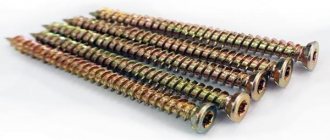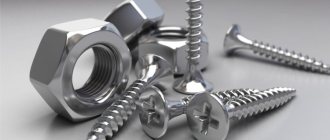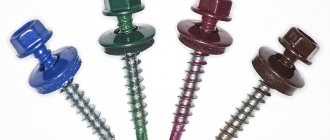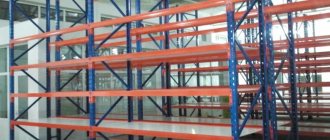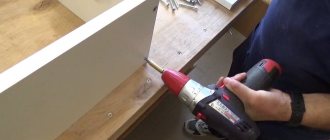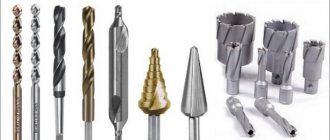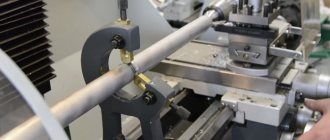During the repair and construction process, it is important that the elements being connected are firmly and reliably fastened together. You can’t do without various hardware. Metal screws deserve special attention. They have become a part of everyday life; various photos of them can be seen in any construction catalogue.
Simple installation, reliability, and fastening strength allow them to be used in various areas of everyday life.
Roofing screws
Self-tapping screws with a hexagonal head have a wide range of applications, but most of all they are used for fastening roofing coverings such as metal tiles and corrugated sheets, as well as components for them, for which they received the general name “roofing”.
- The length of self-tapping screws with a hexagonal head varies from 19 to 100 mm.
- Rod diameter 4.8 and 6.3 mm.
They are equipped with a washer with a rubber gasket, which is responsible for the tightness of the connection, which is important for installing a roof (to prevent leaks).
In terms of color diversity, caps can be of very different colors: red, brown, green, white and others. The color of the cap is matched to the color of the material being fixed and is marked according to the Ral and RR color standards.
There are also self-tapping screws without painting - just with a galvanized head and washer.
To fasten (tighten) these screws, bits with an internal hexagon are used.
Bit size:
- for self-tapping screws with a core diameter of 4.8 mm - 8 mm bit
- with a rod diameter of 6.3 mm - 10 mm bit
Confirmat - furniture screw
.
Confirmats are used when assembling furniture.
The most used ones are 50 mm long with a hex head.
This type of fastener requires mandatory pre-drilling. There is a special confirmation drill for this.
To tighten the confirmations, use hexagons or bits for HEX 4 brand screwdrivers.
Construction wood grouse
A capercaillie is a thick-rod self-tapping screw with a hex head.
Capercaillie are widely used in fastening various units of heavy structures, where special strength and reliability of the connection is required.
When constructing pitched roofs, wood grouse are used for wooden rafter systems and interfloor ceilings.
- The thickness of the wood grouse's rod is from 6 to 10 mm.
- The size of the hexagonal head of wood grouse varies from 10 to 19 mm.
They are tightened manually with wrenches of the appropriate size, or with attachments using ratchets or power tools. Pre-drilling may be necessary.
For fastening to bases made of concrete, brick, foam block, etc., they are used together with a plastic dowel.
Self-tapping bolts for metal
The name “self-tapping screw” has been around for a long time and most people know very well in general terms what this fastener roughly represents.
Builders actively use the same metal screws when carrying out repairs, in construction work and in everyday life to connect various elements. In stores they are sold by weight or in small batches, but large items are also purchased individually.
Construction stores and bases offer a huge selection of self-tapping screw elements - this is the official name for fasteners in catalogs - according to shape, material used, dimensions, purpose and other functions.
Naturally, a number of questions arise on this topic, since an inexperienced beginner may get confused in such diversity, and specialists do not always understand the differences and use one type of fastener for all types of work.
To clarify, this important topic should be analyzed in more detail.
Self-tapping screws for metal
When buying self-tapping screws, every informed buyer focuses on very specific problems that these accessories should solve.
Initially, a logical correlation is observed: for metal a self-tapping screw for metals should be used, for roofing - a roofing screw, and for wood, accordingly, for wood.
Parts used for metal work are presented in two varieties: with a pointed end and a drill end.
With pointed end
The appearance of pointed self-tapping screws used for metal work is very reminiscent of traditional screws from the times of the USSR. They are made of good quality metal and have dense threaded turns, the interridge interval is small. this is done deliberately to improve the connection between the screw and the solid material.
More often there is a spread of screw diameters on metal in the range of 3–5 mm, and its value increases as the length of the product increases.
Manufacturers produce such elements with the following parameters:
- length 10-50 mm with thread pitch 5 mm;
- 60−100 mm in increments of 10 millimeters;
- 11−120 mm with 15 mm thread, quite rare;
- 125−220 mm, cutting 20 mm.
however, the above data is approximate, since there are many manufacturers of this fastener, and the supplier himself regulates the dimensions of the products.
to fix 2 mm metal there is no need to create preliminary holes; the sharp end of the screw will pierce them itself. but with a greater thickness of the elements being connected, it is necessary to drill a passage with a diameter slightly smaller than that of a self-tapping screw for a tighter fit. This method will allow for reliable adhesion to the part.
Self-tapping screws for metal are made from hard grades of first-class steel. They are sold with a galvanized or oxidized protective coating.
The color of commercially available pointed self-tapping screws for metal is mainly black, metallic or gold.
By the type of product you can find out which parts it is intended for connecting:
- parts with large threads, moreover, the threads are high and the pitch between the turns is wide, are used for joining soft materials such as plastic, drywall, wood and plywood.
- fine frequent threads with a small interval between turns are designed for connecting hard wood, high-strength plastic and metal products
- self-tapping screws, where high and low threads alternate, the so-called double-thread, are used when connecting products with different densities, for example, metal profiles and plywood.
with drill end
Such screws have certain differences. characteristic features of such screws from the previous type are:
- the presence of a tip that performs the functions of a drill;
- The head of the product is usually cone-shaped or a press washer.
Self-tapping screws with a drill for metal do not require preliminary drilling of a hole . the tip pierces the material, making a passage for itself and immediately twisting into the base being fastened. The specially shaped cap ensures a tight connection. In case of inaccurate entry, it is not recommended to unscrew the product and reuse it, since the tip will already be blunt.
wood fasteners
They have a distinctive feature - they have a rare thread pitch. It is clear that wood is soft and pliable, not too dense material for construction, which is why the coils are mainly distributed along the core.
The dimensions of the diametrical section of fasteners for wood do not differ from those for metal, and their length varies widely from 11 to 200 mm inclusive.
The smallest representatives of this category of self-tapping screws are called “seeds” in everyday slang, since their shape resembles sunflower seeds,
You can usually screw in wood fasteners without pre-drilling a hole. However, it is advisable to screw a large self-tapping screw with a length of 150 mm and a diameter of 4 mm into a pre-drilled channel so as not to cause cracking of the materials being fastened.
Furniture screws
From the name it is clear that furniture screws are intended for assembling furniture elements. Their length is traditionally 50 mm. It is necessary to screw the confirmations into the prepared channel, that is, a pre-drilled hole, since the end part of the self-tapping screw is blunt.
The head of the fixing screw for assembling furniture has a slot niche for an internal hex key. The diameter of the confirmat is the same along the entire length, but has a smooth thickening in front of the cap so as not to tear off the element under significant loads.
Modern furniture is made mainly from MDF, chipboard and other glued materials, and furniture screws are designed for assembling parts that are not solid in composition. The confirmat has high thread ridges and a fairly flat head, which in total gives good fastening reliability and allows you to recess the head and cover it with a plug to match the base material.
Parts with press washer
This option has already been discussed in the information on self-tapping screws for metal with a drill end, but this type should be separated into a separate subgroup due to an important feature - the presence of an increased contact area of the head. The press washer tightly fastens pressed wooden slats or metal sheets with a thickness of up to 10 mm.
They do not have a characteristic color; usually there are shiny versions of a silver tone.
Hex head element
In appearance, this type of self-tapping screw resembles an ordinary bolt. But nevertheless, it differs in a number of characteristics:
- rare screw thread;
- slightly pointed end.
The main use is for fixing massive elements of large objects. The “hex screw” is usually screwed into wood, but can also be used in concrete when using a dowel. Dowels for hex head screws should be selected according to the diameter and be two sizes larger than the self-tapping screw.
Any work with such fasteners is carried out with 10, 13 and 17 mm wrenches.
Roofing fasteners
The hex head, depending on the size of the screw, comes in only two options - 10 and 8 mm. Roofing screws have the following features:
- end-drill;
- hex head;
- rubber washer-gasket.
The rubber washer-lining performs a dual role:
- a good insulating gasket that prevents moisture from flowing under the cap into the hole for fastening the roof;
- elastic shock-absorbing joint seal.
Self-tapping screws for roofing are manufactured in any color to match existing RAL palettes of roofing materials.
Anti-vandal types
Such screws may be similar in appearance to other options, but upon closer inspection the difference is obvious.
It consists of special types of grooves on the caps; these can be multifaceted, star-shaped or paired notches. They cannot be unscrewed with a regular tool, which explains the name of the fastener.
This article describes the most common types of self-tapping screws found in work.
There are many types, including those with a narrow focus, so it is advisable to try to select exactly those fasteners that are intended for connecting specific materials.
You should not save and use available fasteners, since poor connection of surfaces is possible, which will lead to a violation of the strength of the connection.
Metal screws with drill
- Professional fasteners›
- Self-tapping screws›
The use of metal self-tapping screws with a regular, shortened or reinforced drill facilitates and speeds up installation work on fastening sandwich panels, corrugated sheets, plasterboard, metal tiles, sheet metal and other materials to bases made of metal profiles or metal structures.
What are they?
There are few types of self-tapping seed screws. First of all, they differ in design features.
- Tip shape. “Bugs” can have either a sharp end or a drill-shaped end. Self-tapping screws with a drill are intended for fastening metal with a thickness of 2 mm, and sharp ones - for sheets no more than 1 mm.
- Head shape. All self-tapping screws for gypsum boards have a semi-cylindrical head with a fairly wide base. This allows you to increase the clamping area of the two parts being connected, as well as close the fastening point.
Self-tapping screws are made of low-carbon, durable steel. However, in order to give these hardware increased anti-corrosion properties and thereby increase their service life, the products are coated with a special protective layer. It comes in 2 types.
- Phosphate layer. Self-tapping screws with this top layer are black. Due to this protective layer, the adhesion of the lacquer coating to the hardware is improved, which means that for painting work, “seeds” with a phosphate layer are the best choice. Very often, after installation, such self-tapping screws are coated with a layer of bitumen varnish, which enhances the characteristics of the protective layer in conditions of high humidity.
- Galvanized layer. “Bedbugs” with this type of protective coating have a silver color, an attractive appearance and can even be used on decorative surfaces as a unique design element.
Also, self-tapping seed screws have different sizes and come in several types:
- 3.5x11 – galvanized with a sharp end;
- 3.5x11 – galvanized with drill end;
- 3.5x9 – galvanized sharp;
- 3.5x9 – galvanized with drill;
- 3.5x11 – phosphated with a sharp end;
- 3.5x11 – phosphated with drill;
- 3.5x9 – phosphated sharp;
- 3.5x9 – phosphated with drill.
The dimensions and external coating of the screw are selected based on the operating conditions of the structure, its dimensions, and the materials used.
Manufacturing and installation features
Self-tapping screws with a drill and a sharp tip must be hard, this is the only way they can perform their tasks. This is partly achieved using the material used. The main component in the composition is carbon steel. It allows you to obtain special reliability and immunity to corrosion. Rust resistance also depends on how the screws are made. Special treatment is carried out by coating with appropriate material. This is done in the following ways:
- Galvanizing. The resulting metal screws with a drill with a press washer have a golden or metallic tint. Can serve in bad weather conditions, for example, in damp conditions. Such hardware is used for fastening thin sheets of steel, plasterboard, plastic, chipboard;
- Phosphating. The color of the products is black, the tip is usually sharp. Used for fastening elements to metal profiles and steel sheets.
Metal self-tapping screws are good because you may not need other tools except a screwdriver. There is a limitation to this rule though. The thickness of the metal should not be more than 2 mm for self-tapping screws with a drill and 1 mm for products with a sharp tip. If it is more, then you will have to make a hole with a metal drill. When preparing the hole, it is important to consider:
- Holes are made in both elements that need to be fastened;
- It is advisable to make the hole in the upper element slightly larger than the diameter of the screw. This will increase the clamping force;
If the goal is to do everything reliably, you can take a special formula. The diameter in the lower element is the difference between the diameter of the screw and the square of the height of its thread. The numbers are usually indicated on the fastener markings.
Description and purpose
Self-tapping screws are so-called self-tapping screws. The main feature of such products is that there is no need to make a hole for their installation in advance. These hardware themselves, in the process of screwing in, thanks to their special shape and grooves, create grooves of the required size.
The thread of any self-tapping screw has a triangular shape with sharp edges. Structurally, this hardware is a close relative of the screw, but the latter has less pronounced and sharp thread edges. Self-tapping screws are used for mounting and fixing a wide variety of materials: wood, metal and even plastic. This variety allows you to simplify your work and achieve high installation speed. Drywall also has its own fastening elements - “seeds”.
Self-tapping seed screws differ from all their “brothers” primarily in their small size. But they also have their own design features. The head of the screw-bug has a wide and flat shape, on the edge of which there is a special roller that presses the part it fixes. Most often, this type of fastener is made of galvanized steel or ordinary steel using phosphating.
A type of self-tapping seed screws also includes products with a press. The diameter of such hardware is 4.2 mm, and the length can be very varied. For plasterboard structures, a length of up to 11 mm is used. Self-tapping screws with a press washer are a reinforced type of fastening. This means that thanks to the higher trapezoidal head, the slot is deeper, and therefore the fastener is more reliable.
Depending on what material will be placed on the plasterboard structures - wood, plastic or metal, you can select the most suitable hardware.
Tips for use
In order to work correctly with self-tapping seed screws, you should adhere to the following practical recommendations.
It is very convenient to tighten screws in gypsum boards using a reverse screwdriver. Installation of hardware is carried out using a special bit (Ph2), which controls the drilling depth. Thus, the head of the self-tapping screw, screwed all the way, is flush with the surface of the drywall. A good screwdriver and a suitable attachment are the key to quick and high-quality installation.
Butterfly fasteners are used when working with gypsum boards in cases where it is necessary to attach something quite heavy to the drywall. The device looks like a special plastic dowel with a self-tapping screw. To install it, you must first drill a hole in the sheet. When screwing the hardware, the internal mechanism folds and is pressed very tightly against the back wall of the drywall. There are several fundamental technical points:
- the hole for the “butterfly” is drilled with a diameter equal to the diameter of the dowel, and its depth should be 5 mm greater than the size of the screw;
- Next, the hole is cleaned of dust (using a construction vacuum cleaner), and the fastening can be installed.
The “butterfly” can withstand a load of 25 kilograms.
In order for the fastening of the gypsum board to the profile to be reliable and of high quality, the required number of “seeds” should be taken into account. So, if the frame is made of wood, then the step for installing hardware is 35 centimeters, and if it is made of metal, then from 30 to 60 centimeters.
A variety of fasteners allows you to select high-quality hardware for any type of work. When working with drywall, reliability and speed of installation are important, which is why self-tapping seed screws are so in demand. With their help, all work with gypsum boards goes much faster, and the result is always pleasing.
To see what the “Bedbugs” self-tapping screws look like, see the following video.
How to choose the “right” self-tapping screw
It is not enough to decide on the type of self-tapping screw that is needed for a certain type of work; it is also necessary, among the many options, to choose really high-quality, durable fasteners that will not fail at the most crucial moment. Just carefully inspect the screw. It must meet these simple criteria:
- Same color scheme. All self-tapping screws of one batch must be the same color and shade, if we are talking about black or yellow self-tapping screws. If all products are in the same color, this may indicate that the entire batch has undergone the same type of processing under the same conditions and has the same strength and corrosion resistance.
- The sizes of self-tapping screws from one batch should not be visually different from each other.
- The pitch between threads must be the same.
- If these are self-tapping screws with a drill at the end, then it should not have burrs on the edges, the sharp end of the screw should be without burrs and not broken off.
- The hole in which the slot is made must be clear, symmetrical and deep enough.
- High-quality self-tapping screws are usually marked in the form of a capital Latin letter. This indicates factory production, and it’s also a small hint for you in case you have to buy missing fasteners.
If you see that the screws you have chosen meet the above criteria, then you can be sure that you are holding in your hands really high-quality fasteners that will not break during the installation process.
Product design
The design of the metal fastener includes a head to which a press washer with a wide surface is welded. The shape is very successful, since there is no need to use gaskets. The sheets are pressed quite tightly using this fastener. The recess in the head is often made in the form of a cross: slot Ph No. 2.
Metal screws with a press washer are best used for interior work. For external use, products with an EPDM washer and a rubber or synthetic rubber gasket are used. There is also a head for a hex key. In addition to metal, self-tapping screws are used for fastening plywood, wood, and hardboard. There are several types of self-tapping screw tips:
- With a drill bit - there is a small drill bit at the end that allows you to cut through metals such as iron, aluminum, and stubborn steel. Self-tapping screws with a drill bit are usually stronger than those with a sharp tip.
- Sharp - they fit well due to the shape of the bottom of the screw. A press washer without a drill is also widely used.
It’s also worth saying about the “bugs” self-tapping screws. The name often comes across, for example, in online stores. “Screw bug” is a professional word for builders. In fact, this type of fastener has the following dimensions:
- diameter - 3.5/3.9 mm;
- length - 9.5/11 mm.
Used when installing metal frames for plasterboard products. The head is also in the shape of a washer, but slightly different. It should not be confused with the press washer RMZ TU 7811−7355. Although they have the same goal - to increase the pressure and hold it together more tightly. There are options both with sharp tips and with a drill. In both cases, they are suitable for metal; they “take” wood, drywall and more.
How to choose wood screws
You should not use metal or universal screws to fasten wood. Universal ones are good when you need to twist wood and metal. And when twisting two pieces of wood, they work worse. In the sense that specialized fasteners will hold the wood better. That is, we consider only wood screws. Believe me, there will be plenty to choose from.
Self-tapping screws for wood are better yellow (yes, expensive) or white (a little cheaper)
As already said, wood screws have a rarer thread with a higher profile (the grooves between the turns are deeper). They are used not only for wood, but also for all types of sheet materials: gypsum fiber board, plywood, OSB (OSB), fiberboard and chipboard. Now about when which ones work better.
Carving and other bells and whistles
First you need to choose the type of hat. Countersunk or with a press washer, cylindrical, hemispherical - choose based on what kind of connection you need to make. It is also recommended to choose a TORX type slot, as it best transmits torque from the power tool. Next in order.
- You need to decide whether the thread should be applied to the entire rod or not. If you need to fasten two pieces of wood and pull them tightly together, use a self-tapping screw with an incomplete thread. This means that there should be an area without threads under the cap. The length is equal to the thickness of the attached part or slightly more. Due to this zone, “attraction” of one part to another occurs.
- To make screwing into hardwood or sheet material easier, there are wood screws with a router or mill. The cutter is only available on self-tapping screws with incomplete threads. It looks like several screw-type notches that are applied before starting the carving. The notches soften the wood, after which the self-tapping screw fits better.
- In general, wood screws have a thinner point and this prevents cracking of the wood. But there are also special “lotions” against cracking. These could be: grooves;
- cutting edges in the form of notches on the body of the screw;
- notches on several lower threads.
Are these bells and whistles necessary or is it a waste of money? As for the incomplete carving, this is not news. One part “fits” onto another much more tightly. And try the rest. Only from your own experience will you understand whether it works or not, and what exactly suits you best.
And practical advice on choosing wood screws
It is important that the thread goes straight from the very tip. If the first turn is too far or the tip is blunt, don’t take it
It will be pure torment, not work.
Self-tapping screws for fastening sheet metal up to 0.9 mm thick with a press washer and a sharp tip
These self-tapping screws are used when installing metal sheets up to 0.9 mm thick to metal structures, as well as plastic structures. The head, reinforced with a press washer, ensures reliable clamping of the material to the base, and the galvanized coating allows the product to be used for both interior and exterior work. The heads of such self-tapping screws, equipped with a press washer, can be powder coated in any color according to the RAL table.
When increasing the thickness of the mounted sheet or increasing the thickness of the construction material above 0.9 mm, preliminary drilling of the mounting points is required.
| Head: | semicircular with press washer |
| Slot: | Philips №2 |
| Thread: | small step |
| Tip: | spicy |
| Material: | Steel S1018 |
| Coating: | galvanized |
| The self-tapping screw is designed for mounting sheet material to a metal or plastic base with a thickness of up to 0.9 mm. The semicircular head with a press washer is designed for more tight fixation of the materials being fastened. | |
Table 1. Technical characteristics, dimensions and weight of metal screws with a sharp tip
| Designation | L length, mm | Diam. heads, mm | Diam. press washers, mm | Int. base diameter, mm | External diameter of the base, mm | Surface hardness, HV | Core hardness, HV | Min. destruction moment, N•m | Screwing speed, rpm | Weight 1000 pcs., kg |
| 4,2×13 | 13,0 | 7,1 | 10,6 — 11,4 | 3,2 | 4,05 — 4,3 | 550 | 240 — 450 | 4,5 | 2500 | 1,66 |
| 4,2×14 | 14,0 | 1,73 | ||||||||
| 4,2×16 | 16,0 | 1,89 | ||||||||
| 4,2×19 | 19,0 | 2,04 | ||||||||
| 4,2×25 | 25,0 | 2,45 | ||||||||
| 4,2×32 | 32,0 | 2,87 | ||||||||
| 4,2×41 | 41,0 | 3,60 | ||||||||
| 4,2×48 | 48,0 | 3,78 | ||||||||
| 4,2×51 | 51,0 | 3,87 |
How to screw a self-tapping screw into thick metal?
It is quite possible to screw any roofing screw or galvanized one with a press washer into thick metal, even if the hardware is not equipped with a drill. To do this, you just need to pre-drill the base. Using this method, you can tighten screws even into metal thicker than 5 mm.
The main principle for such operations is that the diameter of the drill should differ from the diameter of the screw by only a few tenths of a millimeter. The thicker the base and the harder the metal, the smaller the difference. For example: for tightening galvanized products 4.2 mm. in metal 2 mm. You will need a drill of 3.5 - 3.8 mm, and for screwing into metal 5 mm. You will need a 4.0mm drill. To achieve this goal, it is worth purchasing several drills, in increments of 0.1 mm, up to the stated diameter of the self-tapping screw.
Before screwing it into a critical place, it is better to drill a test hole and try to tighten the screw. After all, if the diameter is poorly chosen, the cap will easily break off and it will be difficult to remove the stuck tip.
Rate this publication:
- Currently 4.67
Rating: 4.7 (9 votes)
Drilling holes for screws
There are often cases when, before fastening to a self-tapping screw, it is necessary to drill the materials being fastened (pass the fastening point with a drill). This must be done for dense and thin materials. For example, if you try to screw a self-tapping screw into dense oak wood without pre-drilling, the self-tapping screw will simply break off, bend, or significantly under-tighten to the end, and there will be no tightness of the connection (a gap will appear between the connected elements).
When fastening thin parts, pre-drilling is necessary in order to avoid cracks and splits in the thin material being attached.
You can select the diameter of the required drill for drilling for a particular self-tapping screw using this table:
| Self-tapping diameter | Drill diameter |
| 4.0 mm | 2.5-3.0 mm |
| 4.5 mm | 3.0-3.5 mm |
| 5.0 mm | 3.5-4.0 mm |
| 6.0 mm | 4.5 mm |
If the diameters of the drill and the screw are equal, the adhesion density will be very low or there will be none at all.
Tighten the black screws using a screwdriver with a PH2 connector or a similar bit. For golden screws - PZ bit No. 1, No. 2 or No. 3, depending on the diameter of the screw.
Thread
The next point that you need to pay attention to when choosing high-quality screws for metal is the thread. Depending on the type of material that needs to be fastened, it can be:
- Large, with a rare step. Designed to work with non-metallic soft materials: plaster, plastic, wood;
- Average. Available with universal self-tapping screws that can be used to fasten anything;
- With a herringbone profile, for a driven dowel;
- Double-threaded, for working with metal sheets. Such hardware may have a drill at the tip for easy screwing;
- Asymmetrical. Used exclusively in the production and assembly of furniture;
- Variable, with notch. When you need to fasten it to a brick or concrete wall without driving in a dowel, you use a self-tapping screw with this type of thread.
The principle of fastening siding panels
Installation of siding panels is carried out on a frame fixed to the wall. The lathing for installing siding can be made of a wooden block or a metal profile. It is better to install metal siding on metal profiles, given its greater weight than vinyl. To install the panels, oval-shaped holes are made along the edge of the upper side of the panel. They are located quite often, so aligning the mounting hole and the sheathing post is not difficult.
Below the perforation there is a side bent downwards. The next panel is hooked onto this protrusion using a special groove, the size of which corresponds to the protrusion. Which is also attached to the top through perforations. The panels are installed from bottom to top. All additional elements also have similar perforations for fastening. The photo shows a schematic representation of the principle of siding installation.
Self-tapping hex head screw (“hex self-tapping screw”)
In appearance it resembles an ordinary bolt, but differs in the following features:
- infrequent screw thread;
- slightly pointed end.
The main application is the fixation of massive parts and large objects. The “hexagonal self-tapping screw” can be screwed into wood, and if you use a dowel, then into concrete.
Attention! Dowels for hex head screws must be two sizes larger in diameter than the self-tapping screw!
All work with such fasteners is carried out with 17, 13 and 10 mm wrenches. It is clear that the head of the long and thick screw will be 17.0 mm in size, and the shortest one will be 10.0 mm.
Splines
Self-tapping screws for metal are not driven in, but tightened. Their head has specific notches - slots.
It is much more convenient in some situations to use hardware with a hex head, in others - with slots. It is important to understand what kind of metal you will have to deal with - corrugated sheets, angles, channels or pipes of various profiles.
The most common slots that can be seen on self-tapping screw heads are as follows:
- Straight;
- Cross-shaped;
- Star;
- Square;
- Hexagon;
- With a secret.
You also need to understand: some screws (for example, with an asterisk slot) cannot be screwed in in large quantities, since you need to carefully connect the screwdriver bit to the head.
If you are in a hurry or tired, you can ruin the material and “lick the inner edges” of the screws without screwing in the required number.
Lanyard for rigging workCrab system for profile pipes: features of the selection and use of fastening systems and connecting elements
What is a rigging shackle? Size standards, modern types, rules and features of choice
Benefits of siding
There are many reasons for the popularity of siding. The price of siding panels competes well with the cost of other materials for finishing facades: lining made of natural wood, plank - wooden or composite materials, blockhouse, porcelain stoneware, alucobond panels, natural stone. The second reason is ease of installation. Anyone who has held a tool in their hands can decorate the facade of their own house. All work consists of mechanical fastening of standardized parts to the frame.
Choosing screws
A rich assortment of additional parts - window frames, internal and external corners, joining strips - allows for the installation of panels with the installation of decorative architectural decorations of the facade without any production of additional elements. The absence of parts requiring gluing and painting means the siding can be installed in any weather conditions. Unified, well-thought-out facade finishing elements allow for complete installation in a short time.
The mechanical fastening method involves the use of fasteners. Below we will look at how to install the panels so that the facade decoration will last for many years and delight the owner with its appearance.
